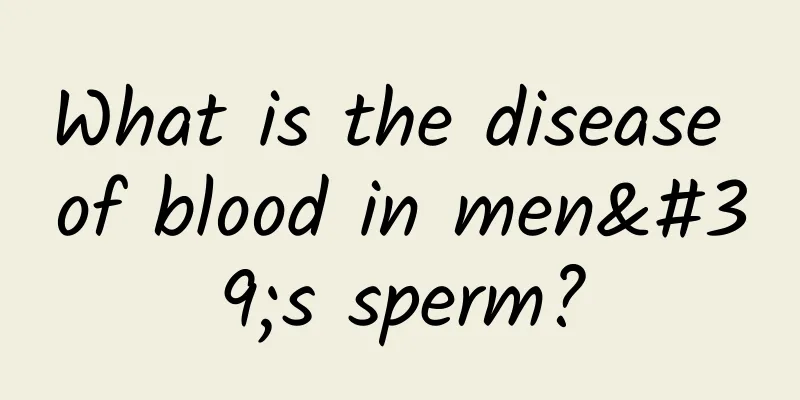What is the disease of blood in men's sperm?

|
If a man's sperm contains blood during ejaculation, it is a serious condition. It means that the man's sexual function has been seriously affected, and it is likely to be related to his prostate. Therefore, he must be actively treated. When a man's sperm contains blood, he will definitely feel pain when ejaculating. So what disease is it when a man's sperm contains blood? Clinical manifestations of hematospermia: Hematospermia is characterized by blood in the semen during ejaculation, which may be accompanied by ejaculation pain, loss of libido, premature ejaculation, perineal pain and discomfort, initial or final hematuria after ejaculation, bladder irritation, etc. The characteristics of functional hematospermia are: if there is no ejaculation for a long time, hematospermia is likely to appear once ejaculation occurs, without other symptoms, and the duration is short and easy to recur. Due to the different causes, locations, amounts and duration of bleeding, the appearance of hematospermia is also different: hematospermia caused by inflammation and injury is evenly mixed; when it comes from bleeding in the urethral mucosa, it is manifested as bright red blood mixed in the semen, which is not mixed with the semen; if the bleeding is stored in the seminal vesicle for a long time, it is often brown; if it is fresh bleeding, it is pink. The vast majority of patients with hematospermia have a small amount of bleeding, which can be the initial, final or whole process of hematospermia. The main cause of the disease Hematospermia can be caused by lesions in various parts and tissues of the semen transport pathway, but it mainly originates from the seminal vesicle, prostate and posterior urethra. Hematospermia can be divided into functional and organic. Functional hematospermia is caused by the contraction of the seminal vesicle when a man reaches orgasm and the relaxation after ejaculation, which causes the pressure of the seminal vesicle to change rapidly, and the capillaries on the cyst wall are damaged, causing bleeding or capillary permeability changes and bleeding. Organic hematospermia is caused by certain diseases, and common causes include: 1. Inflammation Reproductive system infection is the most common cause of hematospermia. Infection pathogens include viruses, bacteria, tuberculosis and parasites, etc. It can also be the result of trauma, urethral foreign bodies, and chemicals. Common ones include seminal vesiculitis, prostatitis, posterior urethritis, seminal vesicle tuberculosis, epididymal orchitis, etc. Stones in the prostate, seminal vesicle or vas deferens can also cause hematospermia. 2. Obstruction or cyst Ejaculatory duct obstruction can cause the proximal end of the obstruction to dilate and swell, leading to rupture and bleeding of mucosal blood vessels. Common examples include seminal vesicle cysts, ejaculatory duct cysts, seminal vesicle diverticula, ejaculatory duct cysts, and prostate cysts. 3. Tumor A variety of benign tumors of the urogenital tract can cause hematospermia, such as posterior urethral adenoma, leiomyoma, fibroma, adenomatous polyp and prostatic hyperplasia. Malignant tumors of the bladder, prostate, testicles and seminal vesicles can also cause hematospermia. 4. Vascular abnormalities Varicose veins of the seminal vesicle, prostatic urethra, and bladder neck are the causes of hematospermia. In addition, vascular abnormalities in the reproductive system can cause hematospermia, including pelvic arteriovenous malformations, prostatic hemangiomas, seminal vesicle and spermatic cord hemangiomas, etc. 5. Damage Most of them are iatrogenic, and are commonly seen in prostate puncture biopsy, intraprostatic drug injection, prostate cancer radiotherapy, transurethral instrumentation or pelvic surgery leading to seminal vesicle damage, and after vasectomy, after extracorporeal shock wave lithotripsy of distal ureteral stones, after hemorrhoid injection treatment, etc. In addition, it is also seen in perineal trauma, gonadal trauma, pelvic fracture, etc. 6. Systemic factors Hypertension, blood diseases (lymphoma, thrombocytopenia, leukemia, hemophilia) and anticoagulant abnormalities secondary to liver disease can cause hematospermia. |
<<: How do boys' breasts get bigger?
Recommend
How to reduce fat on the buttocks, several exercises to slim the buttocks
Although everyone is pursuing an S-shaped figure ...
What are the fastest ways for men to lose belly fat?
With the improvement of living standards, the die...
What are the symptoms of spondylitis? Causes of spinal pain
The spine, lumbar spine, and cervical spine may a...
I still have edema after circumcision surgery for one year
After male circumcision, edema is a very common c...
What foods are good for dry eyes? These three recipes are the best for eye protection
Green bean porridge"text-indent: 2em; text-al...
The ejaculated semen has blood streaks
After a normal male has an erection, if he reliev...
Is it normal for the penis to easily erect?
Only when the penis is erect can sexual intercour...
What are the precautions for prostate stones?
Most patients with prostate stones do not have an...
Principles of circumcision ring removal
If some men have long foreskin, they can choose t...
Is internal examination required for caesarean section?
Many people don’t know what internal examination ...
What are the dangers of taking prostate fluid?
Women living in the 21st century are suffering fr...
What should I do if a small bump grows under the glans?
In today's society, many private parts of the...
Why do men get hard? Why do men get hard?
With the improvement of women's status, many ...
Men and women should be fully prepared for their first time
Whether it is a man or a woman, they all attach g...
Can men eat ejaculation?
Everyone who has had sex or has some knowledge of...









